Blackburn and Darwen WwTWs (2019)
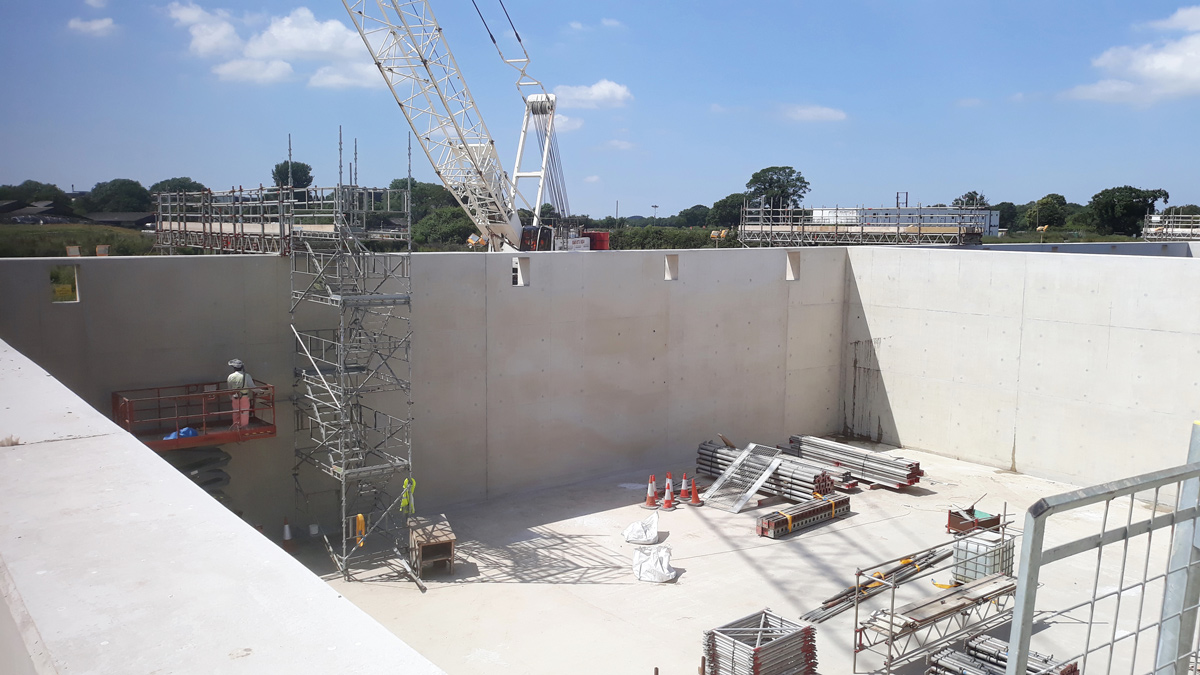
Nereda® tank Cell 5 - Courtesy of United Utilities
Both Blackburn WwTW and Darwen WwTW discharge final and storm effluent to watercourses that are tributaries of the River Darwen, feeding into the River Ribble and ultimately impacting on the bathing waters of the Fylde coast. Following on from the Blackburn and Darwen WwTWs (2017) article and Blackburn and Darwen WwTWs (2018) article, both published in UK Water Projects, the site at Samlesbury near Blackburn, which provides treatment for a population equivalent (PE) of approximately 400,000, has seen significant construction works over the past 12 months. In addition, ferric and caustic dosing plants have been installed at both Blackburn and Darwen WwTWs and a filtration system at Blackburn to achieve UWWTD phosphorus environmental permits that came into force on 14 November 2018.
Undertakings
LiMA, a joint venture between Laing O’Rourke and Atkins, one of United Utilities AMP6 Construction Delivery Partners, was appointed in December 2017 as main contractor for the works at:
- Blackburn Wastewater Treatment Works.
- Darwen Wastewater Treatment Works.
- Darwen Pipeline.
- Nabs Head Inlet Works.
Improvement works at the above four sites will address the AMP6 and AMP7 requirements to improve the river and bathing water quality. The project is on target to be completed in early 2021.
Blackburn Wastewater Treatment Works
The works was built in the 1960s and comprised primary settlement tanks, trickling filters and humus tanks. More recent additions have been a tertiary BAFF and UV treatment, a dedicated pre-treatment plant for the adjacent AB Inbev Brewery and a sludge processing plant.
The works treats principally domestic crude sewage from the Blackburn catchment, with two major additional contributions; a high strength trade effluent from the brewery and an ammonia rich return liquor flow from the sludge treatment plant. The key river water quality/water framework directive parameters within the revised environmental permit are the need to achieve a BOD of 7 mg/l and Ammonia of 1 mg/l both on a 95%ile basis.
It was identified at an early stage the benefits of maintaining a gravity solution through the treatment process, taking advantage of the natural topography of the site and avoiding the need for the ongoing costs of interstage pumping.
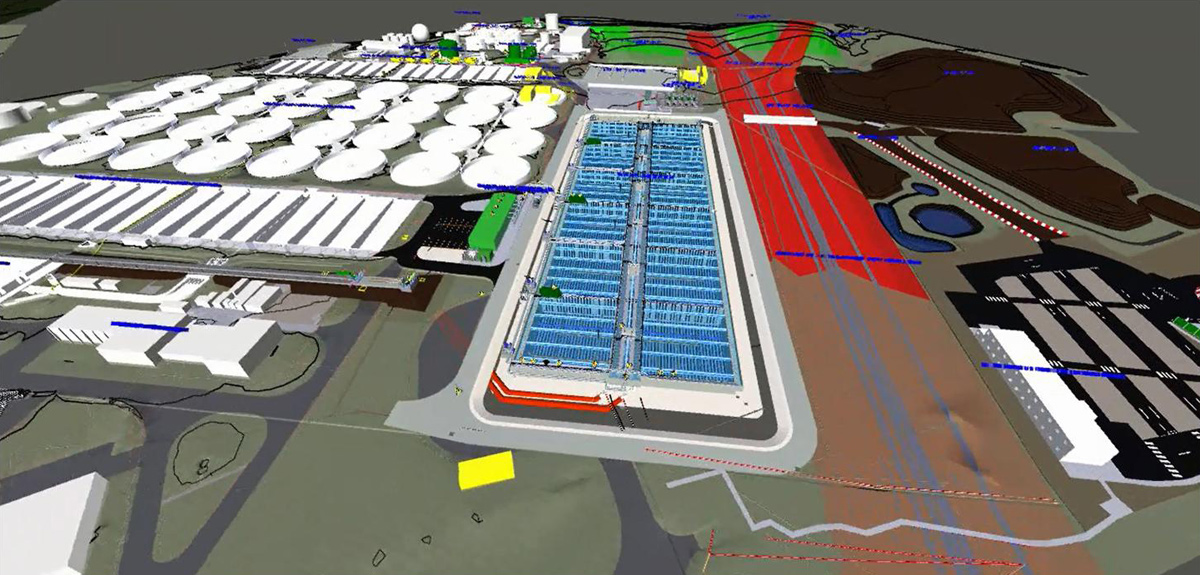
Federated model: 3D visualisation tools – Courtesy of United Utilities
Scope of works: A new inlet channel to feed a 72,000m3 in situ concrete structure which will house the innovative Nereda® aerobic granular biomass technology. The Nereda® system will treat crude sewage that has only received preliminary treatment and has been developed to treat the full flow and peak load at the works; i.e. a complete replacement and expansion of the existing wastewater treatment plant with a flow to full treatment (FTFT) of 3,000 l/s.
The Nereda® structure comprises of:
- 6 x 12,000m3 Nereda® reactors.
- 2 x 800m3 Nereda® sludge buffers.
- 1 x 800m3 Nereda® water level correction buffer.
- Associated aeration and pumping equipment.
This required the excavation of some 84,000m3 of subsoil, generally clay, which was all retained on site in adjacent land owned by United Utilities, and also a move of the main site entrance.
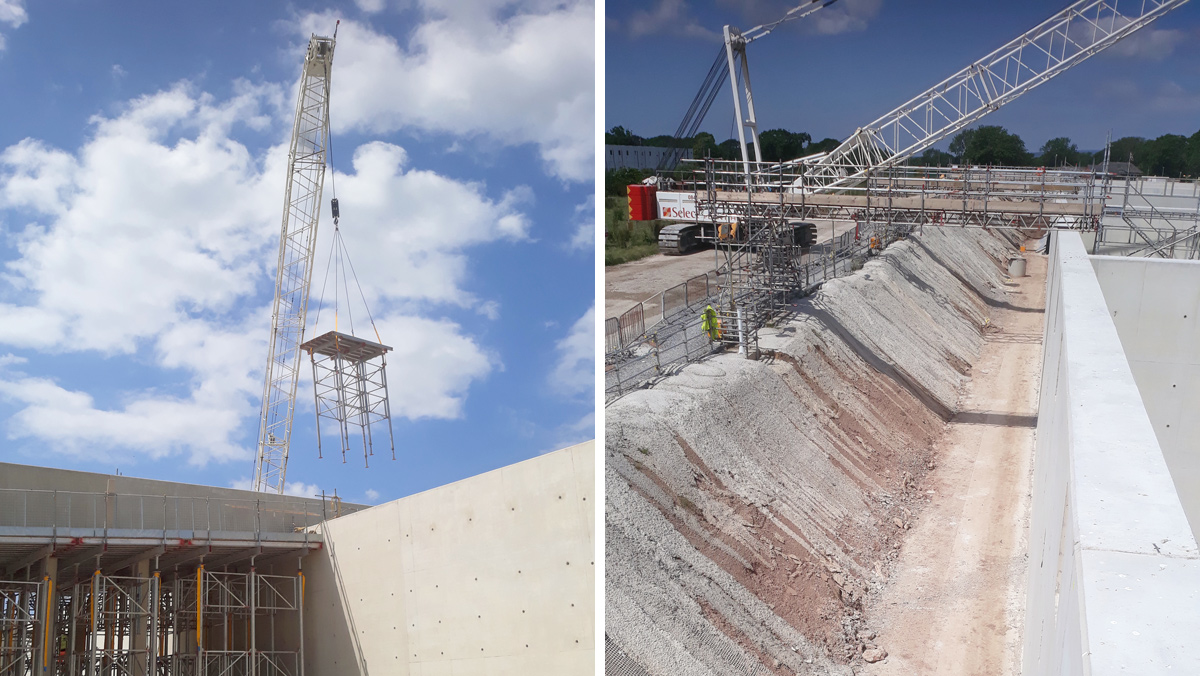
(left) Nereda® tank July 2019: Inside Cell 4 and (right) Nereda® tank side view – Courtesy of United Utilities
Innovative ideas have been utilised to enhance the speed of build. One example is the whole design has been developed using a federated model including the use of 3D visualisation tools. These have been used to facilitate the design development with integration of hazard management, safety and access lifting & maintenance reviews with our operational teams to achieve the most efficient design prior to construction. This in turn is being integrated with our system thinking philosophy to allow operational benefits to enhance the way we maintain and operate the plant in the future from both site and the integrated control centre.
Another example is the successful use of roll mat which has reduced the time for rebar installation in the tank bases at Blackburn and Nabs Head. This also provides a safer installation for site teams carrying out this task. At present (July 2019) the project has utilised approximately 3,500 tonnes of steel and 16,000m3 of concrete peaking at 75 deliveries of concrete per day.
Ferric dosing & tertiary treatment: Other early works at Blackburn have seen the installation of a temporary ferric dosing system, to dose upstream of both the primary settlement tanks and humus tanks to achieve the new phosphorous permit of 1 mg/l from November 2018. The package dosing unit was supplied by Galliford Try which was installed and commissioned prior to the regulatory date.
With potential concerns over levels of iron in the final effluent, it was agreed that the 4 mg/l permit would be at risk without tertiary solids removal. The solution was to arrange for the early delivery of 8 (No.) Eliquo Hydrok Ltd Mecana pile cloth media filters, which were installed together with interstage pumping in a temporary position downstream of the existing humus tanks.
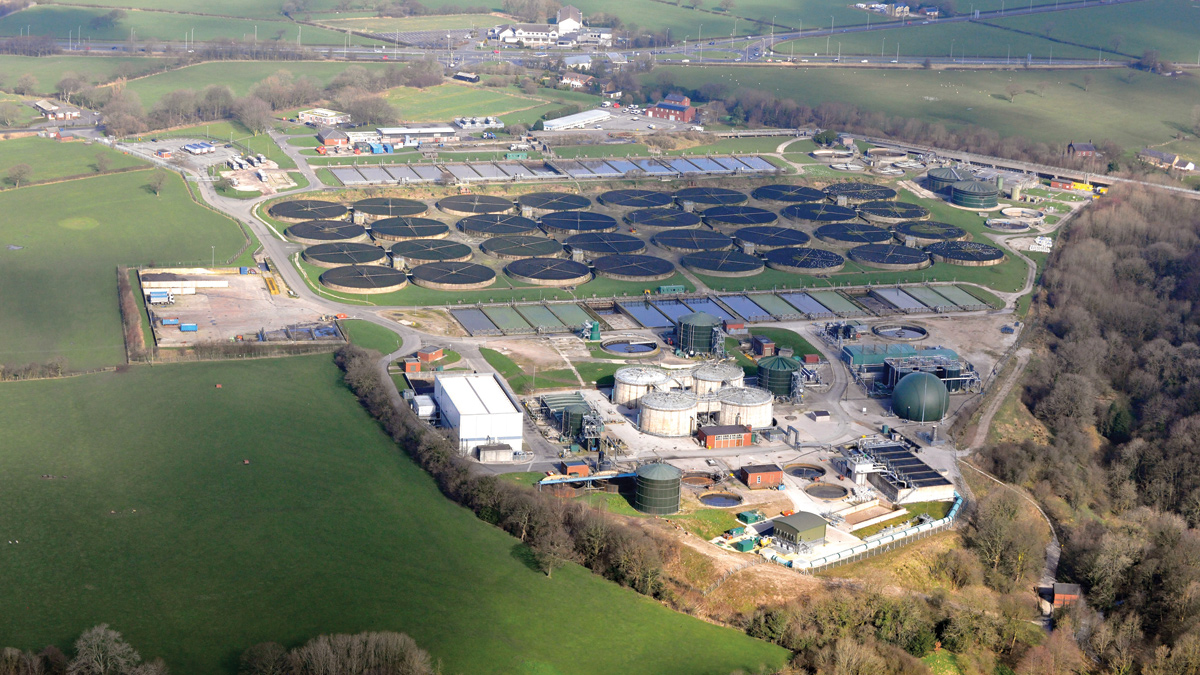
Blackburn WwTW original works – Courtesy of Airviews Photography
BOD compliance: To achieve compliance with the revised BOD permit, it was identified at tender stage that some form of tertiary treatment would be required. The treatment selected was a pile cloth media filters (PCMF) for the removal of suspended solid particles, with 10 (No.) Mecana SF21 filters being required in the permanent installation downstream of the Nereda® plant.
(As mentioned above eight of these are currently installed in a temporary location and will be sequentially relocated as the new works is commissioned).
A new UV disinfection system will also be provided, designed to treat the final effluent prior to discharge and meeting the EA requirements for compliance with the Bathing Water and Shellfish Directives. Several studies have either been undertaken:
- Coastal modelling work has been undertaken by Intertek to determine dilution factors.
- UV transmittance levels have been monitored on the existing site.
- The collection of samples at other sites for collimated beam testing to understand the impact of characteristics of Nereda® based effluent on dose-response.
This work is being coordinated by Stantec UK and will enable the development of a dose-response relationship for the final effluent to be disinfected and also to determine the UV dose required to meet the required concentration for the target organisms.
This will enable the treatment system to be selected based on a site specific information and UV equipment supplied in accordance with the latest UU Asset Standard.
Blackburn & Darwen WwTWs: Supply chain/key participants
- Client: United Utilities
- Project delivery contractor: LiMA
- Civil design: Atkins
- Nereda process: Royal HaskoningDHV
- Darwen pipeline: VJ Donegan Civil Engineering Ltd
- Tertiary filtration: Eliquo Hydrok Ltd
- UV Treatment: Xylem Water Solutions
- Mechanical installation – pipework: FSE
- Nereda internal installation: Crown House Technologies
- Nereda internal installation: Suprafilt
- LV electrical installation, MCCs: Lloyd Morris Electrical Ltd
- Package dosing unit: Galliford Try
- Systems integration: Tata Consultancy Services
- Earthworks: PP O’Connor
- Sealant: G Bulman
- Surfacing: Huyton Asphalt
- GRP Pipe: Amiblu Norway AS
- Feed SAS tanks: Stortec Engineering Ltd
Nabs Head Inlet Works
Nabs Head was the location of Blackburn’s original sewage farm constructed in the 1890s and when the new works was constructed at Samlesbury in the 1960s, the original humus tanks were converted to storm tanks with a capacity of 9,400m3. The inlet works were moved back to Nabs Head in the early 1990s and comprise of screening and grit removal, with an additional 10,700m3 of storm storage constructed in AMP5.
To meet both the Bathing Water Directive requirements of no more than 3 spills per bathing season, and the Shellfish Waters Directive of no more than 10 spills per annum (which proved to be the governing factor), the solution increases the pass forward flow (PFF) to 2,700 l/s from 1,800 l/s, as well as providing another 20,000m3 of storm water storage.
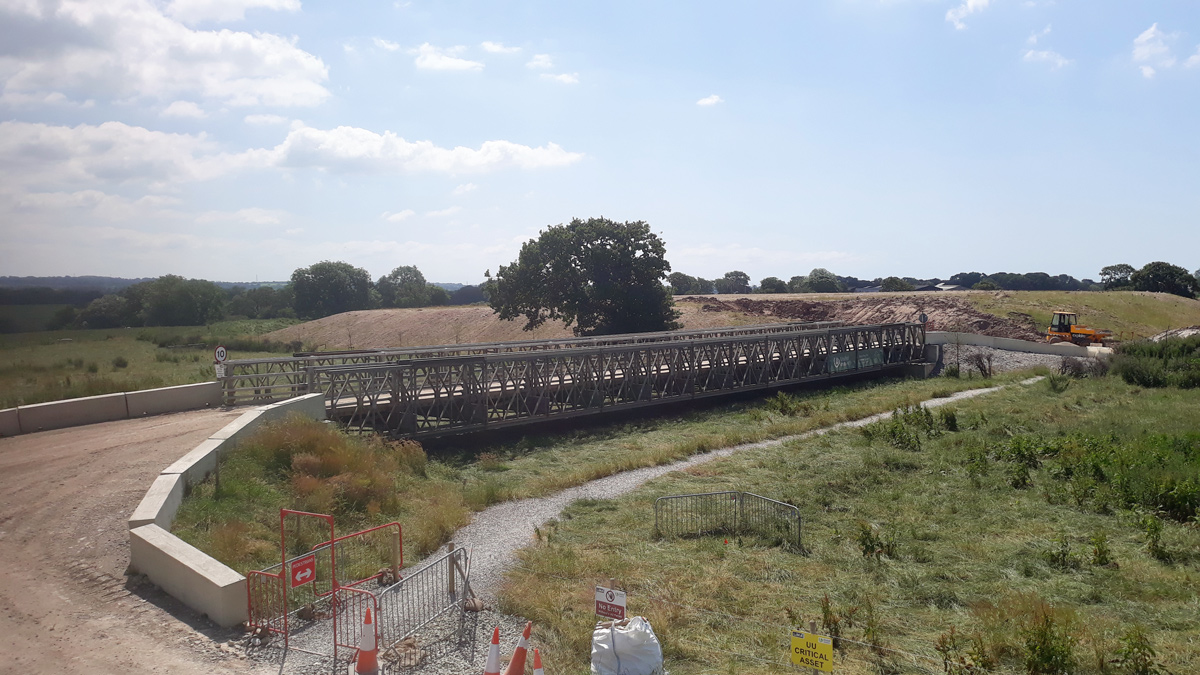
Bailey Bridge crossing and protecting critical assets, (water aqueducts) and 84,000m3 clay mound in background – Courtesy of United Utilities
Storm storage: The storm storage utilises the footprint of the original 1890s storm storage tanks, which had until recently been utilised for sludge storage. The two new blind storm storage tanks are both 102m long by 34m wide and are pumped filled (at up to 3,000 l/s) and empty by gravity, once there is sufficient capacity to pass the flows on to the main works. The original internal walls were demolished and crushed and used for formation for the new concrete tank base. Each tank will be cleaned using a 6-lane Eliquo Hydrok Ltd flushing gate system, to reduce ongoing operating and maintenance costs.
A scale model of the existing CSO channel was constructed by Hydrotec Consultants to ensure that the modified arrangement could deal a range of flows ranging from 30 year storm events to the impact of the return of the storm tank contents during low flows. Hydrotec also built a model of the new storm pumping station to ensure the proposed overflow and baffling arrangement avoided pre-swirl rotation issues with the flows arriving at the 4 (No.) submersible centrifugal pumps.
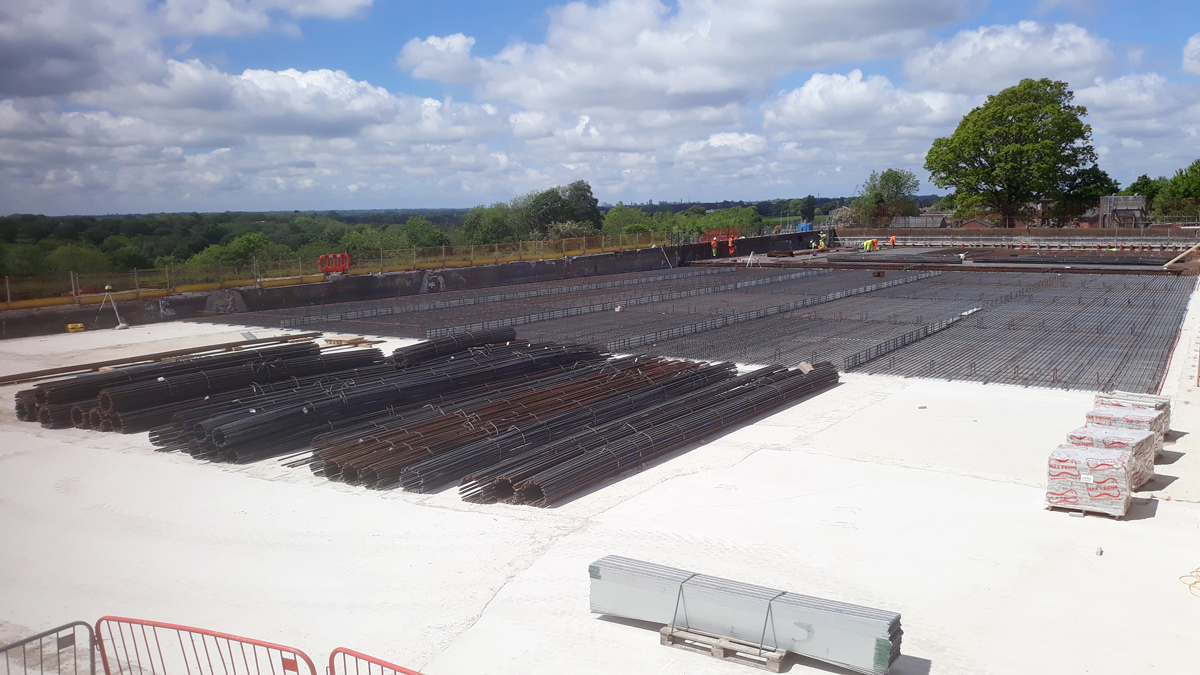
Nabs Head 20,000m3 tank build, base slab rebar lay utilising roll mat – Courtesy of United Utilities
Screenings: Works are also being undertaken to refurbish the 4 (No.) existing Longwood escalator screens and to provide 4 (No.) new Kuhn wash presses to wash and compact the extracted screenings. In addition the two existing cross flow detritors are being refurbished with new grit scrapers, grit pumps and classifiers. Thermal imaging cameras are being used to detect fill capacity on both the screenings and grit skips, to provide a robust operating system without the need for a more complicated auto skip changeover arrangement.
Fibre optics: Further to this a brand new fibre optic link has been installed to enhance signalling between Blackburn WwTW and Nabs Head to allow swifter communication of flow changes and alarms connecting directly into our central management platforms.
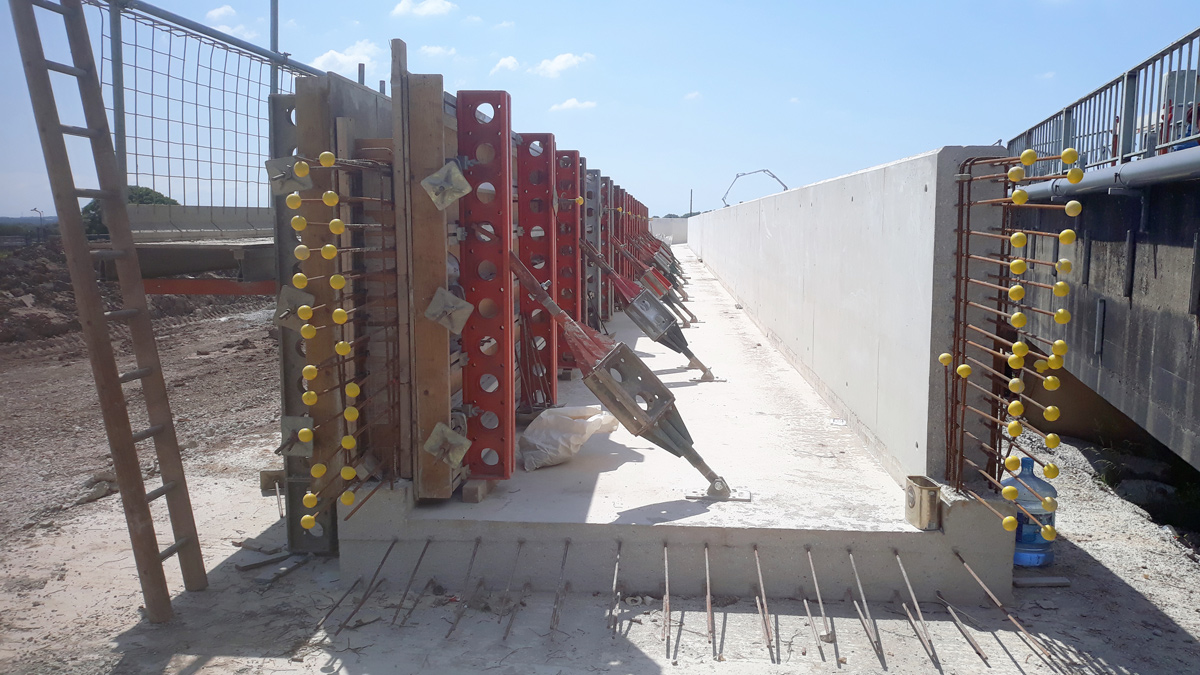
Inlet channel to Nereda® tank under construction – Courtesy of United Utilities
Darwen Wastewater Treatment Works
Like Blackburn the works were built in the 1960s and comprises:
- Inlet works.
- Primary settlement tanks.
- Trickling filters.
- Humus tanks.
A new energy intensive treatment process would have been required to achieve the treatment element of the Water Framework Directive (WFD) driver and the lowest cost solution identified was to abandon the works and transfer flows under gravity into the adjacent Blackburn drainage catchment, ultimately receiving treatment at the new Blackburn WwTW.
Initial works at Darwen required the installation of a ferric dosing system, to dose upstream of the primary settlement tanks and achieve the new phosphorous permit of 2mg/l from November 2018. After initial problems caused by the proposed supplier going into administration, a package dosing unit was supplied by Galliford Try which was installed and commissioned prior to the regulatory date.
The second WFD element at Darwen WwTW required the reduction of intermittent discharges by increasing the volume of storm water storage, to meet the required river water quality (FIS/RE 99%ile) standards. At the time of writing (July 2019) the contractor is determining the most economical way to achieve this; whether by the refurbishment and conversion of what would become redundant primary settlement and humus tanks or by the construction of a purpose built storm tank, both providing some 8,750m3 of storm storage facilities.
Darwen pipeline
This will initially pass underneath the M65 motorway in a tunnel before reverting back to a traditional gravity sewer construction as it passes between a residential development, a river and along Branch Road. The solution submitted at the tender stage for a 1.6km pipeline of 700mm diameter remains substantially unchanged, although with a slight route realignment to avoid passing close to a petrol filling station.
Network modelling work has been undertaken to confirm the storm water storage requirements and ensure that flows diverted from Darwen into the Blackburn catchment cause no ‘level of service’ issues within the existing sewer network.
Discussions are currently ongoing with Highways England to facilitate the necessary Section 61 Agreement for the motorway crossing and works are due to commence later this year, with VJ Donegan Civil Engineering Ltd being appointed as the sub-contractor who will undertake the pipeline work.
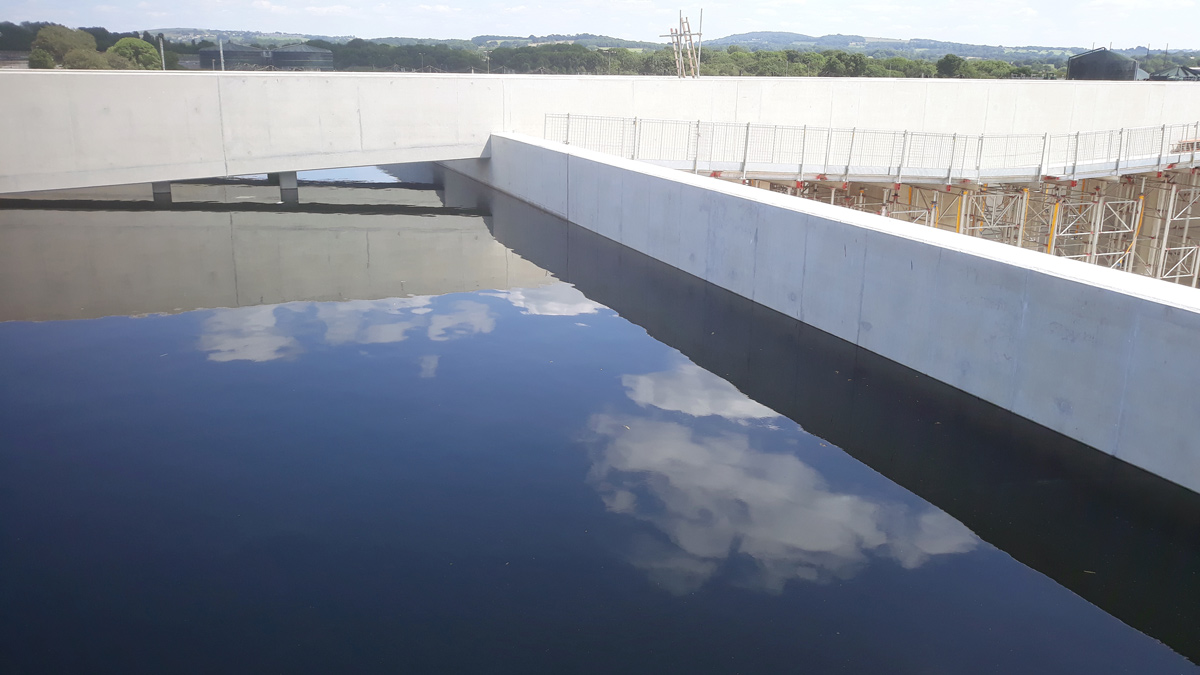
Nereda® tank June 2019: Cell 3 water test (with FE), GASS Structure in Cell 4 – Courtesy of United Utilities
Progress/current status
At the time of writing (July 2019), LiMA have completed 70% of the detailed design, which is scheduled to be significantly complete by October 2019. The Nereda® structure is 100% complete with a water test being successfully undertaken on reactors number 1-4, with mechanical installation works scheduled to commence in August 2019. The project will be completed in 2021.
It is anticipated that United Utilities and LiMA will jointly provide articles highlighting the detail design and construction of this project in future issues of UK Water Projects.













